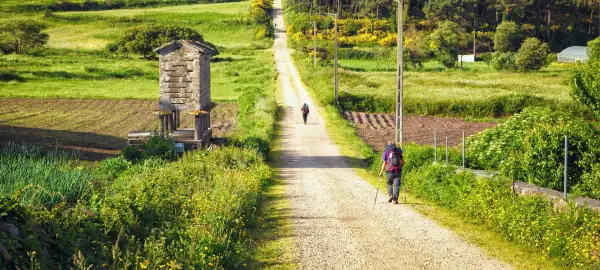- Overview
- Info & Inclusions
- Itinerary
- Map & Hotels
- Photos
- Dates & Prices
- Max Group Size 16
- Museum in Bilbao
- Selected Camino forest walks through Roman roads and medieval villages
- Rioja vineyard experience
- Cruz de Ferro stone ceremony and authentic Santiago Cathedral arrival
- Finisterre coastal walk to Europe's westernmost point
- Gothic cathedrals and Celtic-Christian cultural fusion
- Singles friendly (view options for single travellers)
Each day, we'll traverse picturesque landscapes, from rolling hills to quaint villages, while immersing yourself in the local traditions and stories that bring this region to life. Our expert guides will share the fascinating history and cultural significance of the Camino, highlighting the art, architecture, and heritage that make this journey so unique.
As we walk towards the magnificent Cathedral of Santiago de Compostela, we'll encounter breathtaking Romanesque architecture, savour delicious local cuisine, and connect with fellow travellers from around the world. This journey is an opportunity to reflect, recharge, and rediscover the beauty of Spain's history, culture, and landscapes.
- MealsSavour authentic flavours with included daily breakfasts, some lunches, and most dinners at handpicked local restaurants—immersing you in local cuisine without worrying about reservations or budgets.
- Transport & Logistics
Private air-conditioned coaches and included internal ferries and flights—ensuring hassle-free travel so you can focus entirely on the discoveries ahead.
"Adventures Abroad tour leader's management and guest services managed the tour with great skill and dedication. The tour leader was on top of every move and transfer. We have not experienced any issues with logistics and had a great time."
~ JULIA O"The tour leader did an excellent job coordinating some difficult travel logistics, power outage issues and resolving problems and dealing with guests who had unrealistic expectations."
~ CYNTHIA COLLINS - Expert Guidance
Unlock insider secrets at every landmark with your full-time Tour Leader and expert local guides , all gratuities covered—no hidden tipping surprises—so you immerse fully in your destination's stories, worry-free. (Except for the tips to your tour leader at the end of your tour.)
"Amazing tour guide. Our tour guide was very well organized, Her passion, knowledge, and enthusiasm completely transformed the travel experience into something truly unforgettable..."
~ MELANIE LEMAIRE"Highly recommend every trip with Adventures Abroad. It's a well organized and well thought out adventure. The tour leaders are friendly, knowledgeable and experienced professionals. Highly recommend this company."
~ SUSAN WALL - Sightseeing & EntrancesAll entrance fees for sites visited as per the itinerary—no hidden costs—so you can explore ancient ruins and excursions with complete peace of mind.
- AccommodationsUnwind in clean, well-located 3 to 4-star hotels with private en suite facilities—handpicked for comfort and convenience after each day's discoveries—so you can rest easy knowing your stay supports the real adventure, not steals the spotlight.
- Small Group
Discover the world in small groups of up to 16 travellers plus your expert Tour Leader—unlocking spontaneity, off-the-beaten-path adventures, and genuine connections at a relaxed pace, free from crowds.
"Looking Forward to My Next Adventure The best feature of the Adventures tour was the small size that allowed the group to quickly load up, let everyone get acquainted within the first 24 hours, capitalize on unplanned surprises along..."
~ PHILIP BLENSKI"Good value for a great time I have traveled with Adventures Abroad for over 20 years now. Well thought out, interesting itineraries and the other travelers congenial and friendly. The price always seems fair and overall a..."
~ Trusted Customer - Airport Transfers For Land & Air CustomersWe handle hassle-free airport transfers for all our land and air tour customers—plus early arrivals or late departures when you book extra hotel nights directly with us for added peace of mind.
- International airfare to/from the tour.
- Tour Leader gratuities, lunches, drinks, personal items (phone, laundry, etc), international air taxes (if applicable), excursions referenced as 'optional'.
- Airport transfers for Land Only customers.
- Optional trip cancellation insurance.
- Seasonality and Weather:
Experience northern Spain during two ideal seasons that showcase the region's distinctive character.
Our late September departures capture autumn's harvest festivals, comfortable walking temperatures, and crystal-clear mountain views after summer's haze lifts. Northern Spain's Atlantic climate delivers refreshing mornings and pleasant evenings - avoiding the scorching heat that makes southern Spain challenging during these months.
Our May departures reveal spring's vibrant awakening, when wildflowers carpet Celtic plateaus and oak forests burst with fresh green. Mild temperatures provide ideal walking conditions with longer daylight hours, fewer crowds on Camino paths, and that sense of renewal that has drawn travellers to this legendary route for over a millennium.
Both seasons offer superior conditions while providing distinct but equally compelling experiences of this historic landscape. - Transport and Travel Conditions:
Most transport is by private air-conditioned vehicle, +/- 24 seats depending on ultimate group size (see 'group size'). Due to the winding roads and lack of accessibility on narrow streets in small towns and villages, we will avoid the large motor-coaches more typical of large group touring. One of the delights of exploring this compact region is the lack of long road journeys, allowing us to maximize our time doing, seeing, smelling, tasting, experiencing, and soaking it all in.
While El Camino has, of course, for centuries been a sacred pilgrimage route, in the 21st Century the reasons why one might want to experience this fascinating part of Europe can vary greatly among visitors, and many of our past participants had interests that went well beyond matters spiritual -- history, art, politics, architecture, nature, gastronomy, and recreation. While the religious theme will permeate much of what we so and do, our intention is to deliver a broadly-based experience that will highlight all the many special attributes that makes this part of the world so inviting.
OUR WALKS
Our difficulty rating "Level 3" refers to our walks/hikes that go beyond town/city walking tours on pavement or cobblestones, to hiking on "natural" surfaces (ie gravel) and pathways that feature some elevation gain/loss as opposed to reasonably flat terrain. This activity does not occur every day, but as per our tour itinerary, even when not on a "hike," we will be on foot quite a lot, with town walking tours and plenty of places with uneven surfaces and stairs.
Because some hikes can/may be adjusted at the discretion of your Tour Leader depending on things like weather and group interest, the final distances/durations of our hikes as indicated in our itinerary should be taken as guidance only.
Am I suitable for this tour? Please refer to our self-assessment form - Activity Level: 3
These tours are considerably more strenuous than our Level 1 & 2 "cultural" tours and feature walks/hikes on undulating and uneven pathways for 3-7 hours at a leisurely pace. We don't hike every day, but participants should be fit and active and accustomed to trail walking, possibly in remote locations, and be prepared to engage in a conditioning regimen prior to the trip. Altitude may also be a factor on some tours, though none of our hiking tours currently occur above 3000m/10,000 ft. These are hotel-based tours with no camping, and you are required to only carry what you need for the day.
To learn more about the Activity levels, please visit our tour styles page. - Accommodation:
Well-located, air-conditioned, and often charming/historic 3-4 star hotels throughout. Porter service is sometimes available though you should be independent with your luggage. Single rooms are limited in number and likely smaller than twins. - Staff and Support:
Tour Leader throughout, driver, local guides. - Group Size:
Maximum 16 plus Tour Leader
- Day 1:Arrive in Bilbao, SpainWe arrive in Bilbao and transfer to our hotel.
Welcome to the start point of our multi-themed journey on this fascinating route. While El Camino has, of course, for centuries been a sacred pilgrimage route, in the 21st Century the reasons why one might want to experience this fascinating part of Europe can vary greatly among visitors, and many of our past participants had interests that went well beyond matters spiritual -- history, art, politics, architecture, nature, gastronomy, and recreation. While the religious theme will permeate much of what we so and do, our intention is to deliver a broadly-based experience that will highlight all the many special attributes that makes this part of the world so inviting.
Tonight, we gather with fellow travellers for our first evening meal, sharing anticipation for the historic landscapes, medieval towns, and cultural treasures that await us along this legendary route that has drawn visitors for over a millennium.
Overnight in Bilbao.
Included Meal(s): Dinner, if required - Day 2:Bilbao: The Guggenheim & Cooking ExperienceThe morning reveals Bilbao's extraordinary duality as we explore a city where medieval streets weave between titanium curves. Our guided exploration begins in the atmospheric Casco Viejo, the Seven Streets that formed the original medieval settlement in 1300. We discover the Gothic Cathedral of Santiago, patron saint of our pilgrimage route, and witness how centuries of Basque commerce created this remarkable urban tapestry.
We then proceed to Frank Gehry's revolutionary Guggenheim Museum, where flowing metallic forms mirror the nearby Nervión River. Inside, contemporary masterworks challenge our perceptions while the building itself stands as perhaps the most significant architectural achievement of the late 20th century. The museum's collection spans from modern classics to cutting-edge installations, representing the artistic spirit that permeates our entire Camino journey.
This afternoon we immerse ourselves in Basque culinary traditions through a hands-on cooking experience that reveals the sophisticated techniques behind this internationally acclaimed cuisine. Our private workshop with expert chefs provides intimate access to Basque culinary secrets during a three-hour immersion where we master both traditional and modern pintxos techniques while preparing a complete meal featuring authentic regional flavours. We craft classic offerings alongside contemporary interpretations, learning how this ancient culture continually reinvents itself while honouring its roots.
Overnight in Bilbao.
Included Meal(s): Breakfast and Dinner - Day 3:Bilbao - San Sebastian - PamplonaThis morning we venture to San Sebastián, the elegant seaside city that has elevated Basque cuisine to international acclaim. Our guided exploration reveals why this coastal gem consistently ranks among the world's finest gastronomic destinations, with more Michelin stars per capita than anywhere except Kyoto.
We immerse ourselves in pintxos culture, learning how these sophisticated small plates evolved from simple tavern snacks into an art form. Through the narrow streets of the Parte Vieja, we discover how the Basque tradition of "txikiteo" - moving from bar to bar sampling different specialities - creates a unique social fabric that binds communities together. The elegant La Concha Bay, framed by mountains and dotted with Belle Époque architecture, provides a stunning backdrop to our cultural exploration.
After a break for lunch, we transfer to Pamplona, the historic city forever linked to Ernest Hemingway's literary legacy and the famous Running of the Bulls. Upon arrival, we enjoy a brief orientation tour of this remarkably preserved medieval city, where narrow cobblestone streets lead to the magnificent Gothic cathedral and the atmospheric Plaza del Castillo. Pamplona's well-preserved city walls, built to defend against various invasions, now encircle a vibrant urban center that serves as our base for exploring the Camino's most spiritually significant sections through the Pyrenean foothills.
Overnight in Pamplona.
Included Meal(s): Breakfast and Dinner - Day 4:Pamplona: Roncesvalles Forest WalkToday we experience our first authentic Camino walking as we venture into the legendary Roncesvalles Pass, where Charlemagne's rearguard met its fate in 778 CE and where countless pilgrims have begun their spiritual journeys. This carefully selected 6-8 kilometre forest walk through magnificent beech and oak woodlands captures the essence of the Camino's natural beauty without the demanding 40-kilometre full stage.
Our morning begins at the Collegiate Church of Roncesvalles, a Gothic sanctuary that has welcomed pilgrims since the 12th century. We participate in the traditional pilgrim blessing ceremony, connecting us to the spiritual continuum that has defined this route for over a millennium. The massive silver-plated Virgin of Roncesvalles watches over us as we receive our pilgrim credentials, marking the formal beginning of our Camino experience.
Our walk unfolds through pristine Pyrenean forests where ancient trees create cathedral-like spaces beneath their canopies. These woodlands have witnessed the passage of medieval kings, determined pilgrims, and countless travellers seeking transformation along Santiago's path. The forest's seasonal rhythms - from spring's tender green emergence to autumn's golden transformation - have remained unchanged since the first pilgrims walked these paths.
Following our forest experience, we enjoy a traditional Basque farmstead lunch at a working agricultural operation that demonstrates sustainable farming practices rooted in centuries of experience. We then visit the Orreaga/Roncesvalles Museum, where artifacts and exhibits illuminate the historical significance of this mountain crossing that connects France with Spain.
NOTE: Vehicle support ensures optimal positioning for our walk and comfortable return to Pamplona.
Hike Summary: 2-3 hours of easy to moderate walking covering 6-8 km (4-5 mi) through beech and oak forest paths. Gentle undulating terrain with approximately 200 metres (656 ft) total elevation change on well-maintained forest trails.
Overnight in Pamplona (dinner on your own this evening).
Included Meal(s): Breakfast and Lunch - Day 5:Pamplona: Ancient Roman RoadsOur second Camino walking experience follows ancient Roman engineering through the 8-10 kilometre circuit from Santa María de Eunate to Cirauqui. This carefully selected section showcases the remarkable Roman road construction that still supports modern pilgrims, demonstrating how infrastructure built two millennia ago continues serving contemporary travellers.
We begin at the enigmatic Santa María de Eunate, an octagonal Romanesque church whose unusual design continues puzzling historians and architects. Some scholars connect its geometry to Templar traditions, while others see influences from Holy Land architecture brought back by Crusaders. Our guided exploration reveals the sophisticated engineering and symbolic elements that make this 12th-century structure one of the Camino's most mysterious monuments.
The walking portion follows authentic Roman road segments where original stone paving remains remarkably preserved. These roads, built with typical Roman precision, feature carefully graded surfaces designed to shed water while providing secure footing for heavily laden travellers. We understand how Roman engineering expertise enabled the expansion of empire and later facilitated medieval pilgrimage routes.
Our afternoon in Estella reveals a medieval city that prospered from Camino commerce, developing into what contemporaries called "little Toledo" for its remarkable cultural diversity. The town welcomed Jewish, Muslim, and Christian merchants who created a cosmopolitan atmosphere rare in medieval Europe. We explore the Palace of the Kings of Navarre, a rare example of Romanesque civil architecture, and understand how Camino towns developed sophisticated urban planning to accommodate international pilgrims.
NOTE: Selected sections of Roman road construction, not the full traditional stage. Vehicle positioning optimizes our walking experience.
Hike Summary: 3-4 hours of moderate walking covering 8-10 km (5-6 mi) through historic Roman road sections and medieval towns. Mixed terrain with approximately 150 metres (492 ft) total elevation change on ancient stone paths and modern walkways.
Overnight in Pamplona.
Included Meal(s): Breakfast and Dinner - Day 6:Pamplona - Wine Experience & Santo Domingo de la Calzada - BurgosThe Camino's cultural richness extends far beyond spiritual seeking, encompassing the agricultural traditions that have sustained northern Spain for centuries. This morning we immerse ourselves in Rioja's winemaking heritage through an extended vineyard visit.
We'll understand how seasonal rhythms have governed rural life since Roman times, and participate in barrel tasting sessions that reveal how Rioja's unique terroir - combining Atlantic and Mediterranean influences - produces wines of extraordinary complexity. The viticulture workshop demonstrates sustainable farming practices that preserve soil health while producing premium grapes.
Our traditional lunch with a winemaker family provides intimate insight into rural Spanish culture, where multiple generations continue family traditions while adapting to contemporary challenges. These meals, featuring seasonal ingredients and time-honoured recipes, represent the authentic hospitality that has welcomed Camino pilgrims for centuries.
The afternoon brings us to Santo Domingo de la Calzada, a town literally created to serve pilgrims by an 11th-century hermit-engineer who built bridges, hospitals, and roads to ease the journey to Santiago. The cathedral houses one of the Camino's most beloved legends - live roosters commemorating a miracle involving a wrongly accused pilgrim. This remarkable story, where a roasted chicken supposedly came back to life to prove innocence, demonstrates how Camino culture blends faith, folklore, and community memory.
We conclude with exploration of the historic parador, a former pilgrim hospital that now provides luxury accommodation while maintaining its medieval character.
Overnight in Burgos (dinner on your own this evening).
Included Meal(s): Breakfast and Lunch - Day 7:Burgos:- Medieval Village CircuitToday's kilometre walking experience connects remarkable medieval villages through landscape that epitomizes Castile's austere beauty. Our selected route from the Castrojeriz area to Frómista church reveals how Camino communities developed sophisticated support systems for pilgrims while maintaining their agricultural foundations.
We begin exploring Castrojeriz castle ruins, dramatically positioned on a limestone outcrop that has commanded this valley since Roman times. The medieval fortress protected both the Camino route and the fertile agricultural lands that sustained local communities. From these heights, we comprehend how strategic positioning determined medieval settlement patterns and understand the complex relationship between military necessity and economic opportunity.
Our walking continues through landscape that embodies Castile's essential character - vast horizons, golden grain fields, and scattered villages clustered around ancient churches. This terrain has remained largely unchanged since medieval times, allowing us to experience the same sweeping vistas that inspired and challenged countless pilgrims over the centuries.
The afternoon's highlight awaits at Frómista's San Martín church, considered the purest example of Romanesque architecture along the entire Camino route. Built in 1066, this perfectly proportioned structure demonstrates the sophisticated architectural knowledge that medieval builders brought to even modest rural communities. Every carved capital tells a story, from biblical narratives to fantastical creatures that populated medieval imagination.
We also visit the Canal de Castilla interpretation center, which explains how 18th-century engineering ambitions attempted to transform Castile's transport infrastructure through ambitious waterway construction.
Hike Summary: 3-4 hours of moderate walking covering 8-10 km (5-6 mi) through medieval villages and agricultural countryside. Mostly flat terrain with gentle undulating sections and approximately 100 metres (328 ft) total elevation change on village paths and rural tracks. Scenic village-to-village portions selected for optimal cultural experience, not the demanding full traditional stage.
Overnight in Burgos.
Included Meal(s): Breakfast and Dinner - Day 8:Transfer to León via El Cid & Gregorian ChantOur departure from Burgos begins with exploration of Spain's most legendary hero through an El Cid historical tour that reveals how Rodrigo Díaz became immortalized in literature and legend. Burgos Cathedral, a UNESCO World Heritage masterpiece, houses El Cid's tomb and demonstrates how Gothic architecture reached Spain through Camino cultural exchange. Our enhanced cathedral visit includes the atmospheric crypt, where medieval stonework creates spaces of profound contemplation.
Arriving in León, we encounter one of Spain's most magnificent Gothic cathedrals, famous for its ethereal stained glass windows that earned the nickname "House of Light." Our enhanced tour includes roof access, providing spectacular views across the Meseta plains while understanding medieval construction techniques that created these soaring stone poems.
Non-walking day
Overnight in León.
Included Meal(s): Breakfast and Dinner - Day 9:Meseta Plains Experience & Transfer to AstorgaThe Camino's character transforms dramatically as we enter the Meseta, Spain's vast central plateau where pilgrims confront both physical challenges and spiritual opportunities in landscape of profound simplicity. Our 8-10 kilometre plains walk from Hospital de Órbigo bridge captures the essence of this demanding terrain without requiring the full 20-kilometre traditional stage.
Hospital de Órbigo's medieval bridge spans the Órbigo River at a location that has witnessed remarkable historical drama. In 1434, the knight Suero de Quiñones held a famous tournament here, challenging 300 knights to combat in honour of his beloved. This "Paso Honroso" tournament lasted a month and became legendary throughout medieval Europe, demonstrating how Camino towns attracted international attention through spectacular events.
Our Meseta walking experience reveals landscape that challenges and transforms pilgrims through its very austerity. The seemingly endless horizons, punctuated only by occasional villages and distant church towers, create contemplative conditions that have inspired spiritual breakthroughs for centuries. This terrain strips away distractions, forcing pilgrims to confront their inner landscapes while navigating the physical demands of Spain's high plateau.
The afternoon brings us to Astorga, an ancient Roman city that became a crucial Camino crossroads where multiple pilgrimage routes converge. Our cathedral tour reveals magnificent Baroque and Gothic elements, while Antonio Gaudí's Episcopal Palace demonstrates how innovative architecture can honour traditional functions. Gaudí's fantastical creation, with its fairy-tale turrets and innovative structural solutions, represents the creative spirit that continues influencing Spanish art and architecture.
Hike Summary: 3-4 hours of moderate walking covering 8-10 km (5-6 mi) across Meseta plains and rural countryside. Mostly flat terrain with minimal elevation change, approximately 50 metres (164 ft) total, on packed earth paths and traditional Camino routes.
Overnight in Astorga.
Included Meal(s): Breakfast and Dinner - Day 10:Cruz de Ferro Mountain Section & Transfer to LugoToday's mountain walking experience leads us to one of the Camino's most emotionally powerful locations, the Cruz de Ferro, where pilgrims have deposited stones for over a millennium in rituals that transcend specific religious traditions. Our 8-10 kilometre forest approach through pristine mountain terrain captures the spiritual essence of this Camino highlight without requiring the demanding full 30-kilometre stage from Astorga.
The morning begins with a cultural presentation exploring Celtic-Christian fusion, the remarkable synthesis that created Galician spiritual traditions. We understand how pre-Roman Celtic beliefs merged with Christian symbolism to produce unique expressions of faith that continue influencing regional culture. This cultural blending, evident in everything from stone crosses to folk music, demonstrates how the Camino facilitated religious dialogue long before modern ecumenical movements.
Our mountain walk unfolds through pristine oak and chestnut forests that have remained essentially unchanged since medieval times. These woodlands provide habitat for countless species while creating cathedral-like spaces beneath their ancient canopies. The gradual ascent reveals how Camino walking becomes meditation in motion, where physical rhythm and natural beauty combine to create conditions for personal reflection.
At Cruz de Ferro, we participate in the ancient stone ceremony where pilgrims deposit rocks carried from home, symbolically releasing burdens while expressing hopes for the future. This massive cairn, accumulated over centuries of pilgrim devotion, represents one of humanity's most enduring collective rituals. The simple iron cross mounted on a wooden pole has witnessed countless personal transformations and continues serving as a powerful focus for contemplation.
Our transfer to Lugo includes scenic route stops that reveal Galicia's distinctive landscape, where green hills and ancient settlements create some of Europe's most beautiful rural scenery.
Hike Summary: 3-4 hours of moderate to challenging walking covering 8-10 km (5-6 mi) through mountain forests with steady ascent to Cruz de Ferro. Approximately 400 metres (1,312 ft) total elevation gain on forest paths and mountain trails.
Overnight in Lugo.
Included Meal(s): Breakfast and Dinner - Day 11:Lugo & Celtic GaliciaLugo preserves one of Europe's most complete Roman legacies through its magnificent walls, the only Roman fortifications that completely encircle a living city. Our morning walk along these 2-kilometre ramparts, built in the 3rd century CE, provides spectacular views while demonstrating imperial engineering that has protected this settlement for over 1,700 years. The UNESCO World Heritage walls feature 85 towers and multiple gates, creating an urban fortress that enabled Lugo to survive countless medieval conflicts.
The Cathedral of Santa María reveals how Romanesque, Gothic, and Baroque styles layered onto Roman foundations, creating architectural palimpsests that record centuries of cultural evolution. The cathedral's remarkable retablo and medieval cloister demonstrate how Camino wealth funded artistic achievements in even provincial cities.
Our Celtic plateau walking experience leads us through 6-8 kilometres of elevated terrain around O Cebreiro village, where Celtic culture maintains living traditions despite centuries of cultural change. These rounded hills, scattered with ancient palloza houses, preserve pre-Roman settlement patterns while supporting agricultural practices that date back millennia.
O Cebreiro's 9th-century church houses remarkable treasures, including the Holy Grail of medieval legend and a 12th-century miracle that attracted pilgrims from across Europe. The traditional palloza houses, with their distinctive thatched roofs and circular stone construction, represent building techniques perfectly adapted to mountain weather conditions.
Hike Summary: 2-3 hours of easy to moderate walking covering 6-8 km (4-5 mi) through Celtic plateau terrain and Roman wall circuit. Gentle undulating landscape with approximately 150 metres (492 ft) total elevation change on ancient walls and highland paths.
Overnight in Lugo.
Included Meal(s): Breakfast and Dinner - Day 12:Santiago Final ApproachThis morning marks our formal preparation for Santiago arrival through a pilgrimage ceremony in Lugo, where we receive final credential stamps and participate in traditional rituals that connect us to centuries of Camino completion. These preparations honour both personal achievement and collective pilgrimage tradition, acknowledging our shared journey with countless previous travellers.
Our authentic 8-kilometre final approach follows the classic route from Monte do Gozo to Santiago Cathedral, the traditional path that has provided pilgrims' first glimpse of their destination for over a thousand years. Monte do Gozo, the "Mount of Joy," earned its name from medieval pilgrims' emotional reactions upon seeing Santiago's cathedral towers after months of walking. This final approach represents the culmination of every Camino journey, where anticipation builds with each step toward the ultimate destination.
The descent toward Santiago reveals the cathedral's twin towers growing larger against the Galician sky, just as countless pilgrims have experienced this moment of triumph and fulfilment. Our first arrival in Plaza del Obradoiro coincides with the traditional ringing of cathedral bells, a ceremony that celebrates each group's successful completion of their pilgrimage journey.
The Plaza del Obradoiro itself represents one of Europe's most magnificent urban spaces, where the Baroque cathedral facade faces the elegant Hostal dos Reis Católicos, originally built as a pilgrim hospital by the Catholic Monarchs. These buildings create a theatrical setting for the emotional climax of Camino completion.
Our celebratory Galician feast features regional specialities while we participate in a traditional queimada ceremony, where flaming aguardiente mixed with coffee beans, lemon peel, and sugar creates both spectacle and symbolic conclusion to our pilgrimage journey.
Hike Summary: 2-3 hours of moderate walking covering 8 km (5 mi) from Monte do Gozo to Santiago Cathedral. Gentle descent with approximately 100 metres (328 ft) total elevation loss on traditional Camino paths and urban walkways.
Overnight in Santiago de Compostela.
Included Meal(s): Breakfast and Dinner - Day 13:Santiago de Compostela ExplorationSantiago Cathedral stands as one of Christianity's most significant pilgrimage destinations, housing the supposed remains of Saint James the Apostle while showcasing nearly a millennium of architectural evolution. Our comprehensive cathedral tour includes the museum and remarkable roof access, providing perspective on both artistic treasures and urban development that made Santiago a medieval metropolis.
The Portico de la Gloria, Master Mateo's 12th-century sculptural masterpiece, represents medieval art at its most sophisticated. These carved figures seem to breathe with life while illustrating complex theological concepts through visual narratives that educated illiterate pilgrims. The opportunity to touch the Tree of Jesse, polished smooth by millions of pilgrim hands, connects us directly to this tactile tradition.
Our cathedral roof access reveals engineering solutions that medieval builders developed to support massive stone vaulting while creating spaces for contemplation and worship. From these heights, we comprehend Santiago's urban development and understand how Camino wealth transformed a remote Galician settlement into an international cultural center.
The afternoon's historic quarter exploration includes the Gelmirez Palace, where medieval archbishop-lords governed both spiritual and temporal affairs with remarkable sophistication. The palace's Romanesque architecture and historical exhibits demonstrate how Camino success enabled provincial cities to achieve artistic and intellectual prominence.
Free time allows personal reflection and market exploration, where contemporary Galician culture continues traditions that developed through centuries of international pilgrimage influence.
Overnight in Santiago.
Included Meal(s): Breakfast and Dinner - Day 14:Finisterre "End of the World" ExcursionOur journey concludes with the traditional extension to Finisterre, the "End of the World" where medieval Europeans believed the earth terminated in vast Atlantic waters. This excursion completes the full Camino experience by reaching the geographic conclusion that ancient pilgrims considered the spiritual culmination of their journey.
We begin with a drive to Muxía, a fishing village where dramatic coastline meets powerful Atlantic swells in landscape of raw natural beauty. Our 3-4 kilometre coastal walk around the sanctuary reveals how Christian tradition adapted pre-Roman sacred sites, creating syncretistic expressions of spirituality that honour both ancient and medieval beliefs.
The drive to Finisterre lighthouse follows rugged coastline where Celtic culture maintained traditions that predate Roman conquest. These communities developed sophisticated maritime knowledge while creating artistic expressions that influenced European cultural development far beyond their geographic isolation.
Our clifftop walk encompasses 2-3 kilometres of spectacular Atlantic coastal paths where we experience the literal edge of the medieval world. The lighthouse, perched on cliffs that drop dramatically to churning seas, marks the westernmost point of continental Europe and the traditional conclusion of Camino pilgrimage.
Our traditional seafood lunch overlooking the Atlantic Ocean features Galician specialties while we contemplate the achievement of reaching this symbolic world's end. The "End of the World" ceremony provides traditional conclusion to Camino pilgrimage, acknowledging both personal transformation and geographic achievement.
Hike Summary: 2-3 hours of easy to moderate walking covering 5-7 km (3-4 mi) along Atlantic coastal paths. Undulating clifftop terrain with approximately 100 metres (328 ft) total elevation change on well-maintained coastal walkways and clifftop trails.
Overnight in Santiago.
Included Meal(s): Breakfast, Lunch and Dinner - Day 15:DepartureOur Camino journey concludes with departure from Santiago de Compostela, carrying memories of landscapes that have inspired travellers for over a millennium. We leave having experienced not just Spain's most famous pilgrimage route, but a cultural journey that revealed how historical currents shaped European civilization through centuries of international exchange.
Transfer independently to Santiago de Compostela airport for your onward journey.
Buen Camino! Bon Voyage!
Included Meal(s): Breakfast
Countries Visited: Spain
*The red tour trail on the map does not represent the actual travel path.
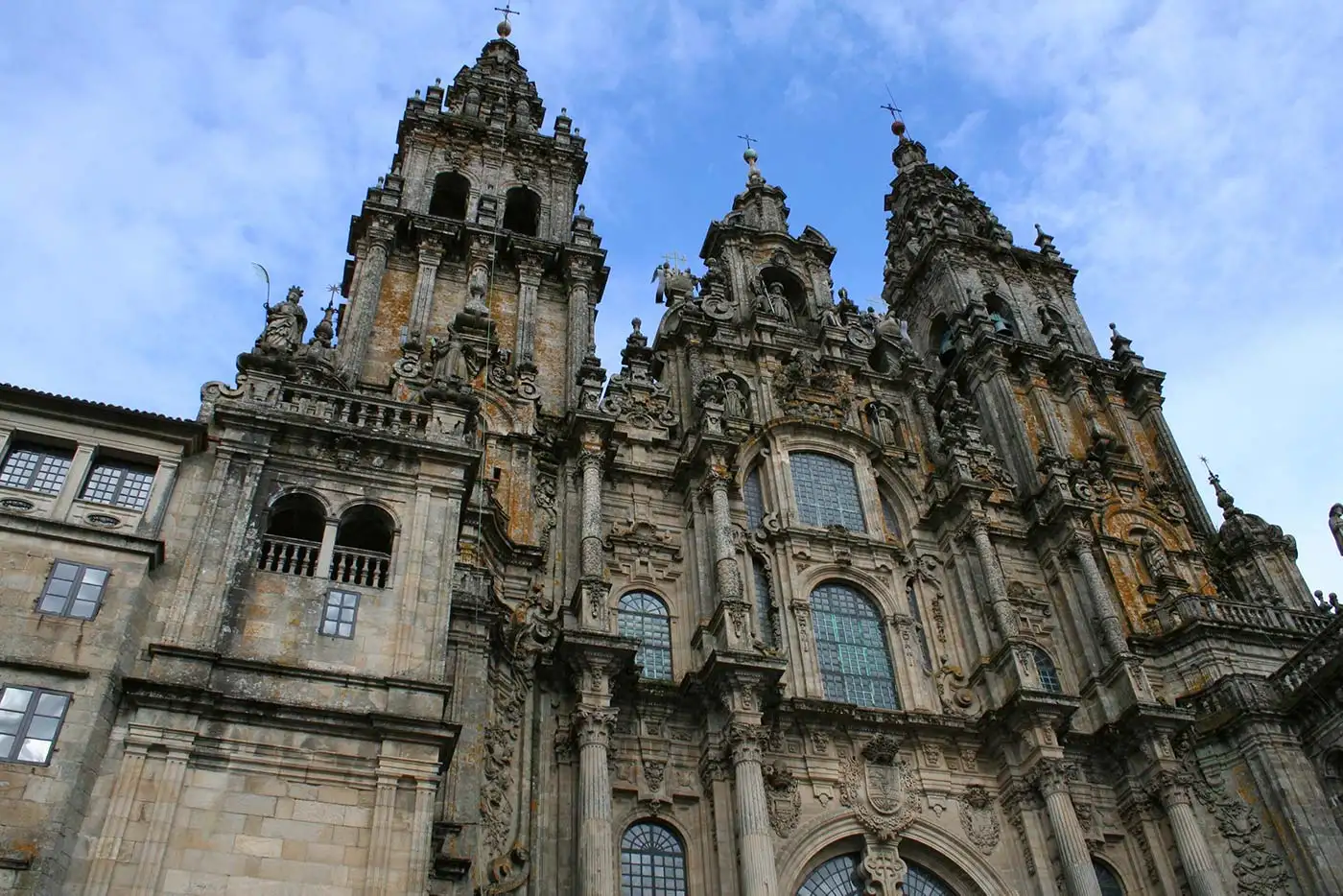
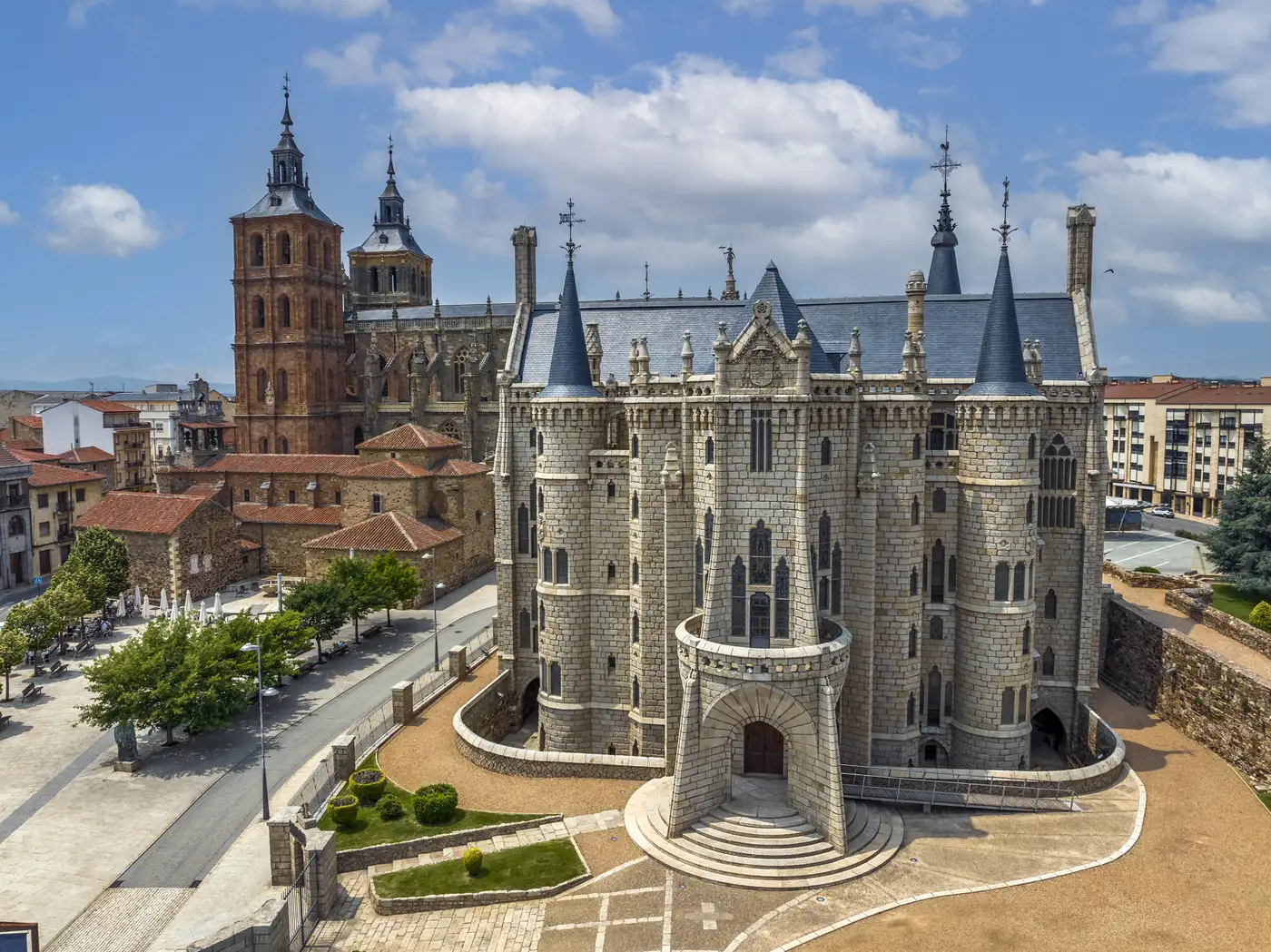
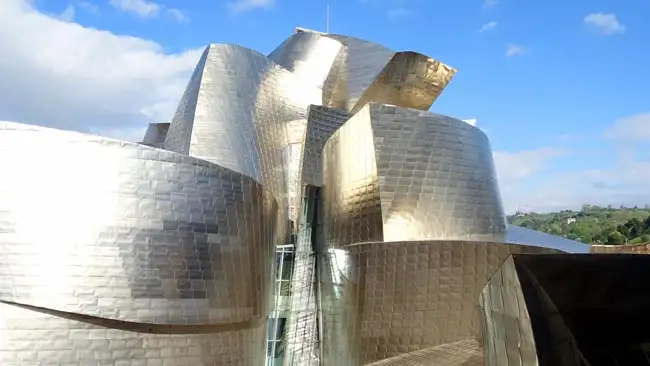
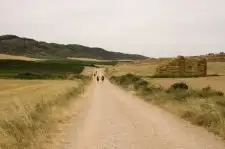
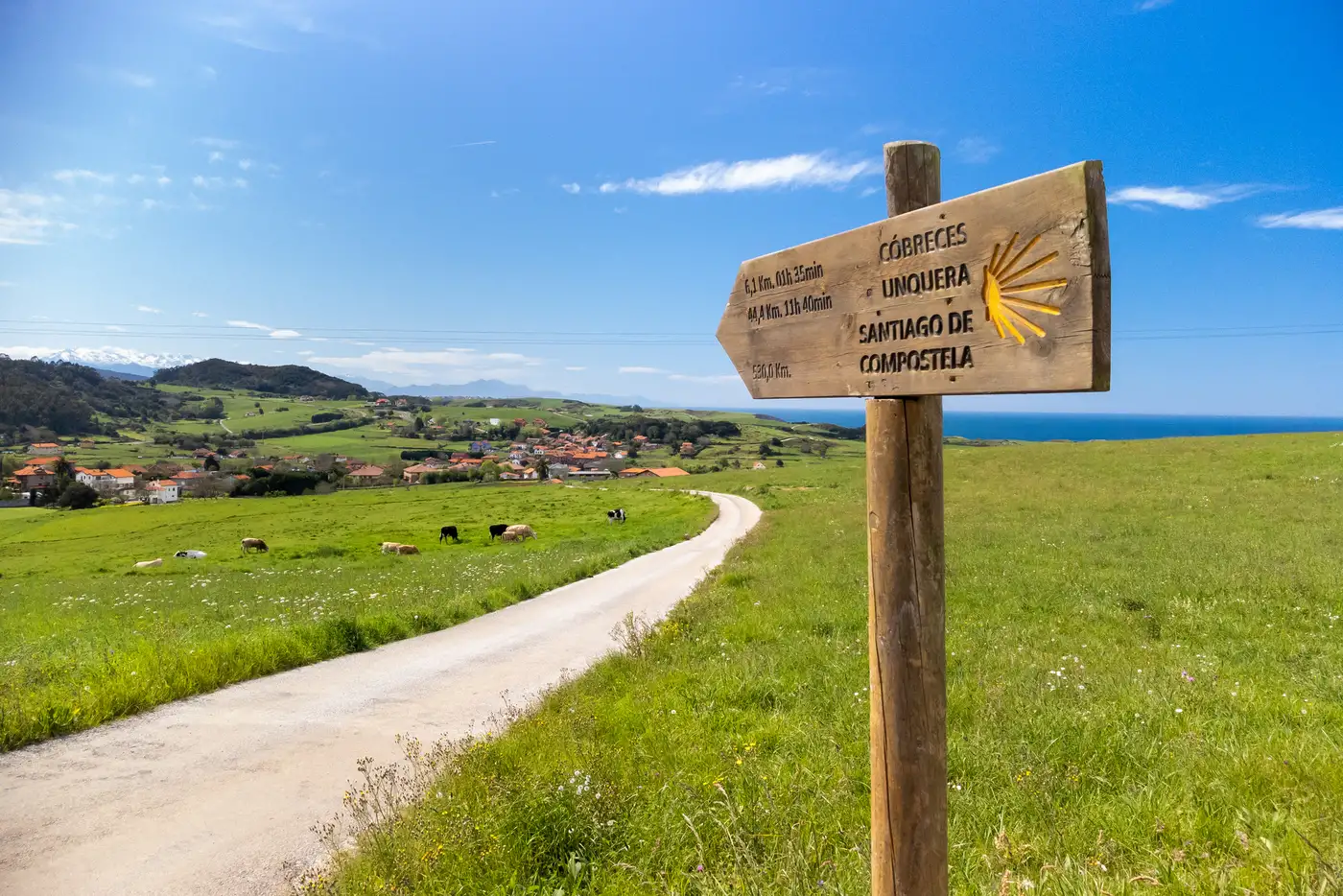
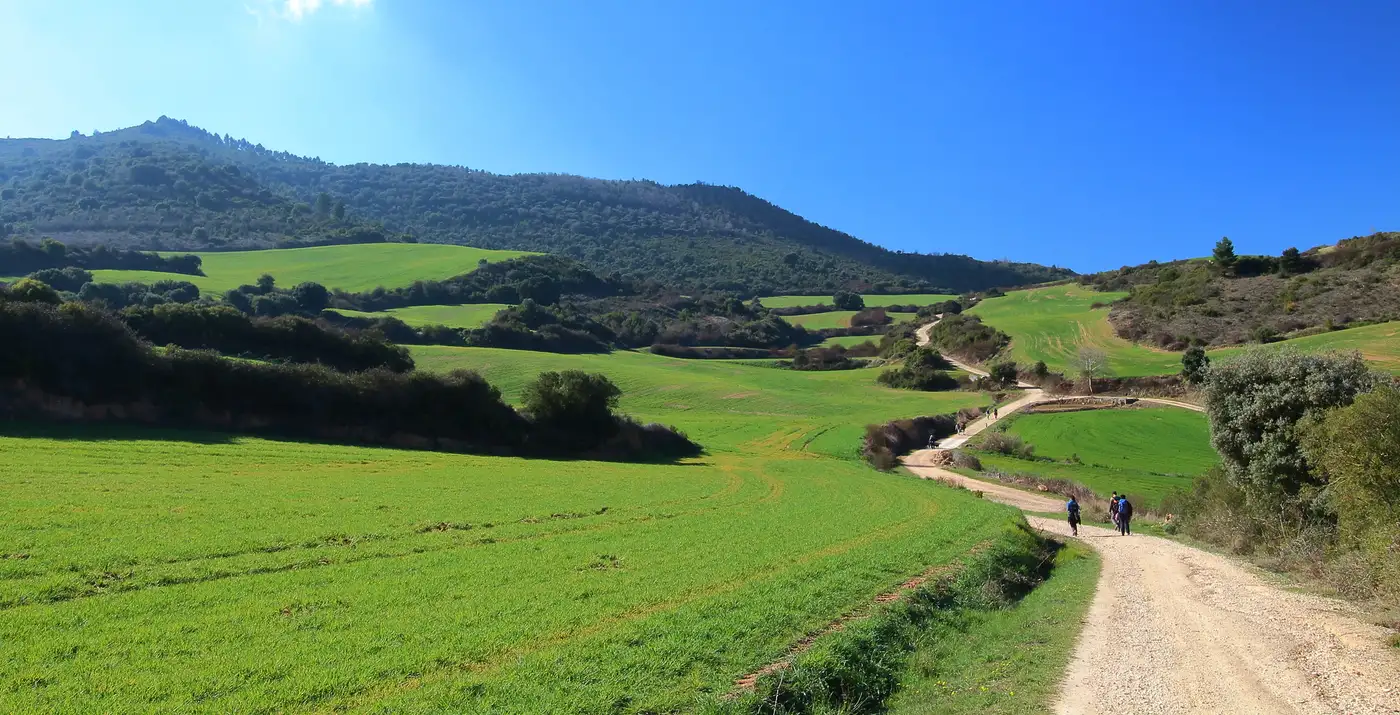
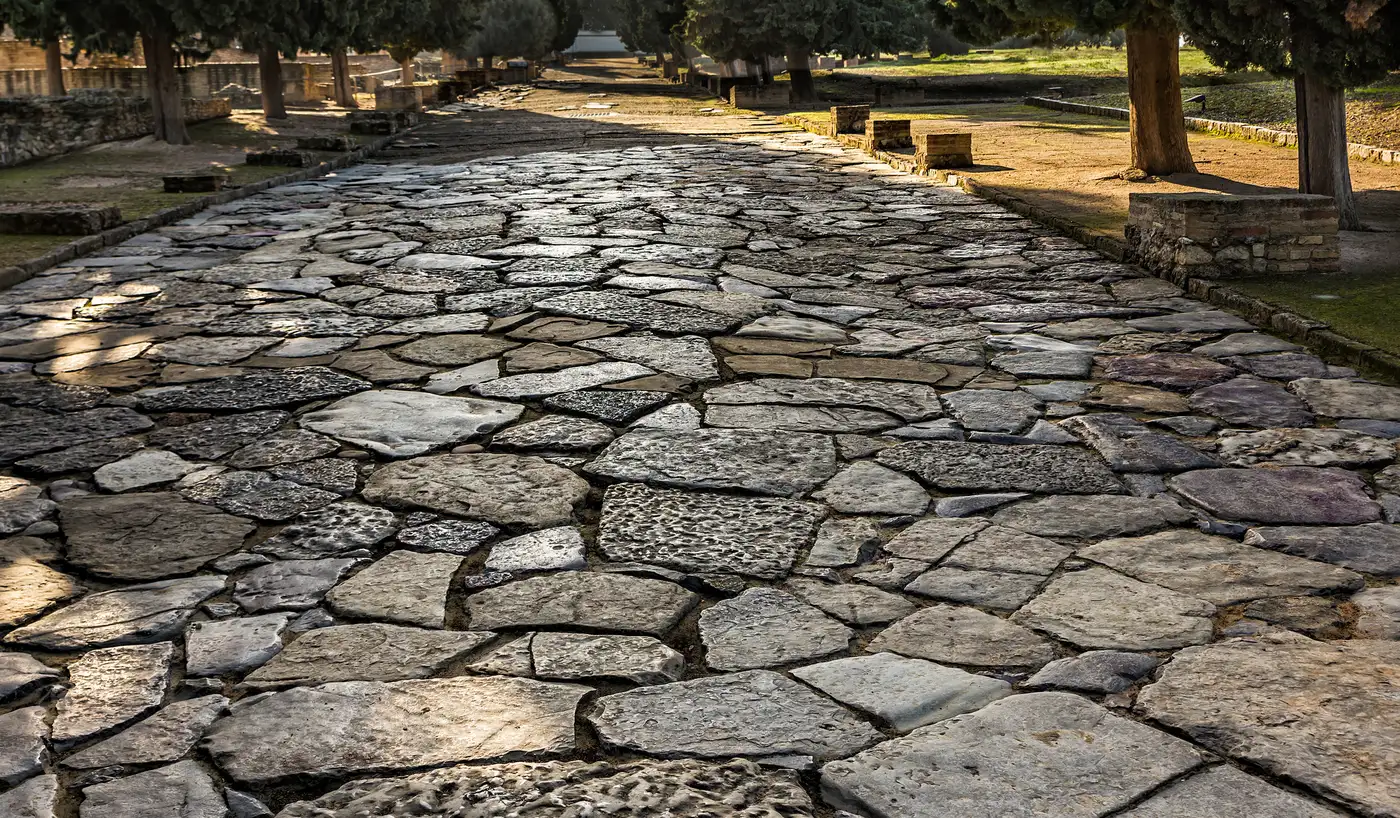
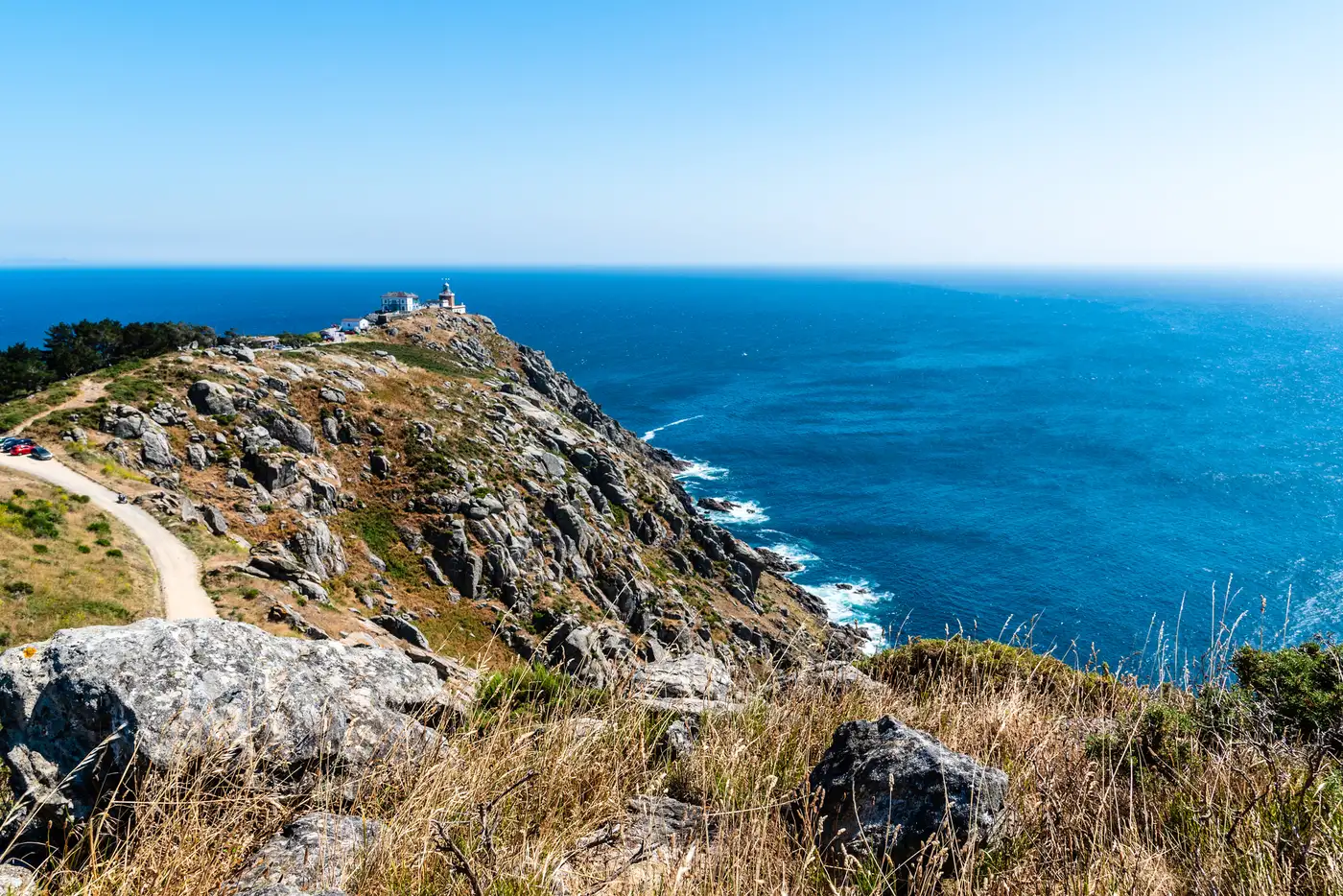
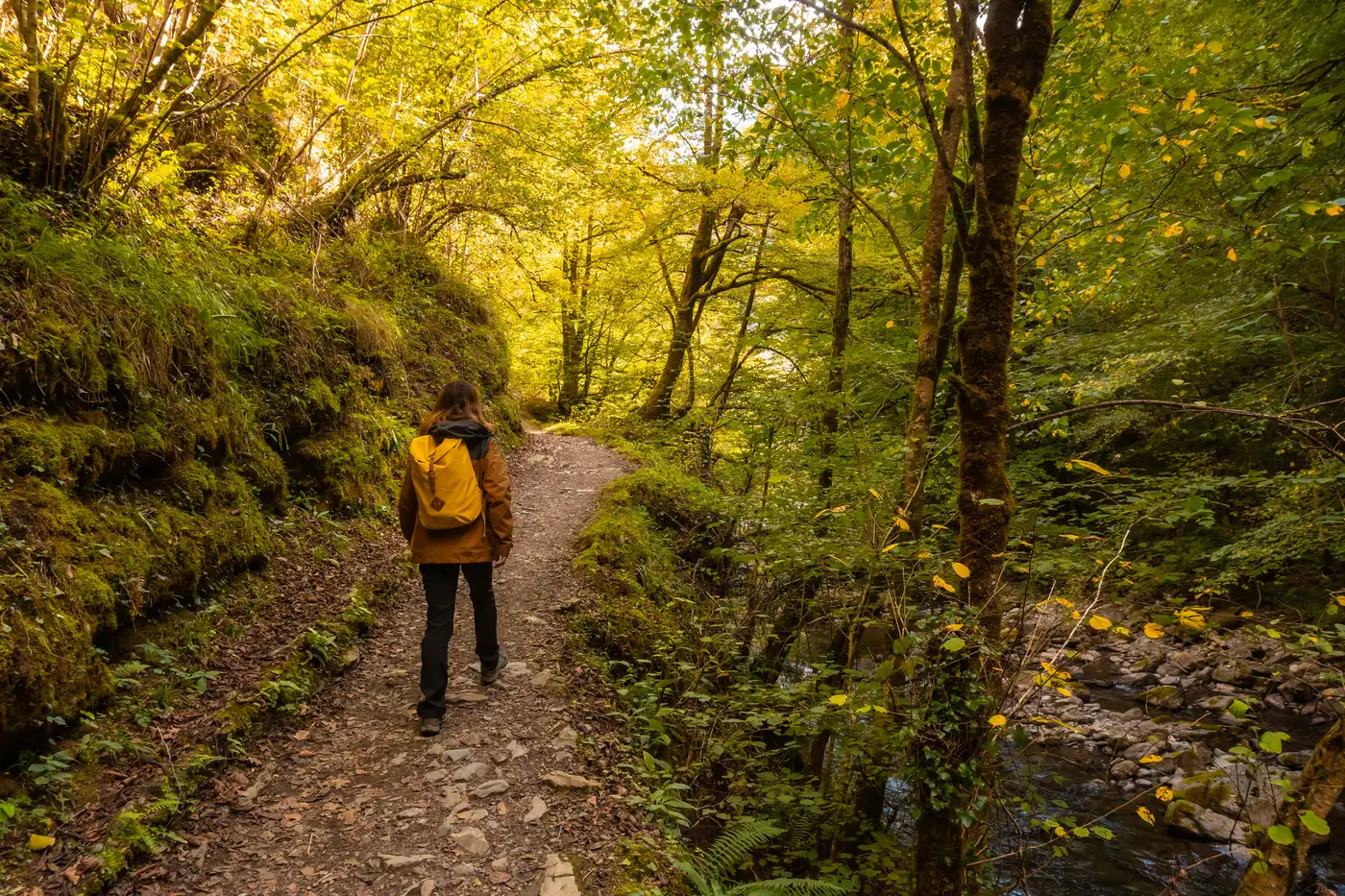
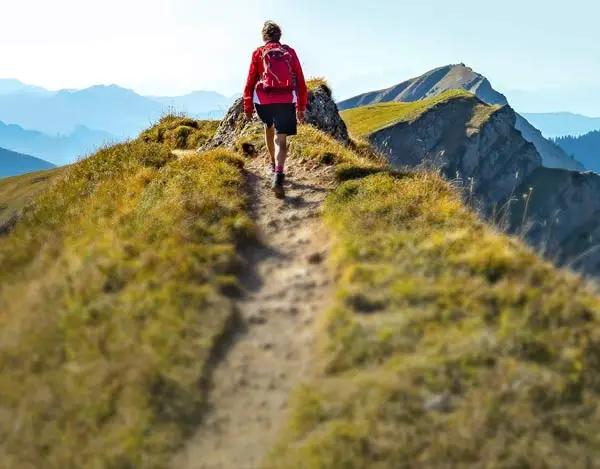
Book This Tour
- Final payment: Due 90 days prior to departure.
- Deposit: A non-refundable $500 CAD Deposit is required at booking.
- Optional Single Supplement: $1970 CAD (number of singles limited).
(View options forsingle travellers) - Transfering Tour or Date: Transferring to another tour or tour date is only permissible outside of 120 days prior to departure and is subject to a $100 CAD change fee.
(Read our cancellation policy)
Prices below are per person, twin-sharing costs in Canadian Dollars (CAD). Pricing does not include airfare to/from the tour and any applicable taxes.
Frequently Asked Questions
- What is the maximum number of participants on a trip?Most of our tours carry a maximum of 18 participants; some tours (ie hiking tours) top out at 16. In the event that we do not achieve our minimum complement by our 90-day deadline, we may offer group members the option of paying a "small-group surcharge" as an alternative to cancellation. If all group members agree, we will confirm the trip at existing numbers; this surcharge is refundable in the event that we ultimately achieve our regular minimum. If the small group surcharge is not accepted, we will offer a refund of your deposit or a different trip of your choice.
- Can I extend my tour either at the beginning or end? What about stopovers?Yes, you can extend your tour either at the beginning or the end and we can book accommodation in our tour hotel. Stopovers are often permitted, depending on air routing. Stopovers usually carry a "stopover" fee levied by the airline.
- How do I make a reservation? How and when do I pay?The easiest way to make a reservation is via our website; during office hours, you are also more than welcome to contact us by telephone.
A non-refundable deposit is payable at the time of booking; if a reservation is made within 90 days, full payment is required. Some trips require a larger deposit. If international airline bookings require a non-refundable payment in order to secure space or the lowest available fare, we will require an increase in deposit equal to the cost of the ticket(s).
Early enrolment is always encouraged as group size is limited and some trips require greater preparation time.
Once we have received your deposit, we will confirm your space and send you a confirmation package containing your trip itinerary, any visa/travel permit related documents, invoice, clothing and equipment recommendations, general information on your destination(s), and forms for you to complete, sign and return to us. Your air e-tickets (if applicable), final hotel list, final trip itinerary, and instructions on how to join your tour, will be sent approximately 2-3 weeks prior to departure. - What about cancellations, refunds, and transfers?Please review our cancellation policy page for details.
- I am a single who prefers my own room. What is a single supplement?All of our tours have a single supplement for those who want to be guaranteed their own room at each location.
This supplement is a reflection of the fact that most hotels around the world do not discount the regular twin-share rate for a room by 50% for only one person occupying a room. Most hotels will give a break on the price, but usually in the range of 25-30% of the twin-share rate. This difference, multiplied by each night, amounts to the single supplement.
The conventional amount can also vary from country to country and some destinations are more expensive than others for single occupancy. In order to be "single friendly," the supplements we apply are not a profit centre for us and we do our best to keep them as reasonable as possible.
On most tours we limit the number of singles available, not to be punitive, but rather because many hotels allow for only a limited number of singles; some smaller hotels at remote locations also have a limited number of single rooms available.
Please note that most single rooms around the world are smaller than twin-share rooms and will likely have only one bed. - Do you have a shared accommodation program?Yes! If you are single traveller and are willing to share, we will do our best to pair you with a same-gender roommate. Please note that should we fail to pair you, we will absorb the single supplement fee and you will default to a single room at no extra charge.
